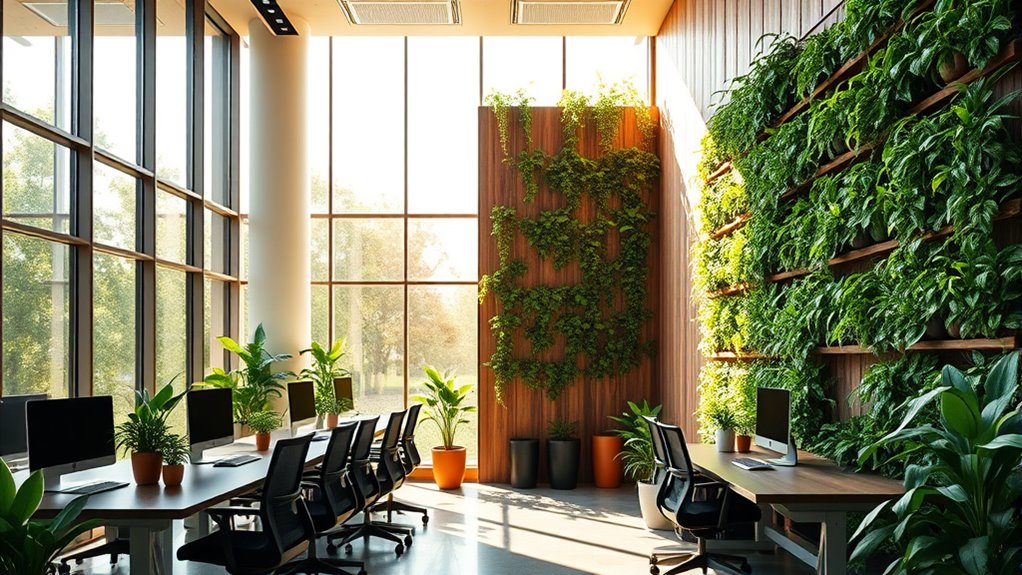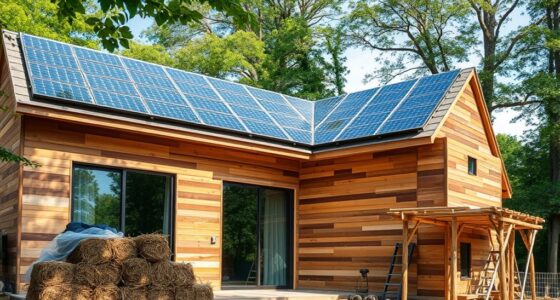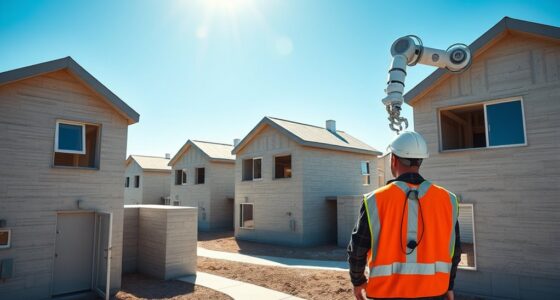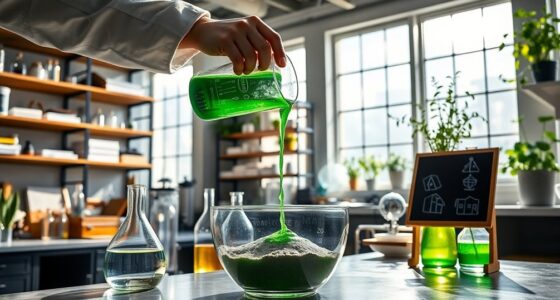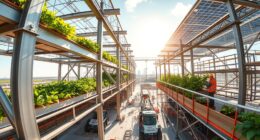Biophilic design is transforming office spaces by integrating natural elements like plants and sunlight to boost your well-being and productivity. When you incorporate greenery and optimize natural light, your work environment becomes more inviting, healthier, and energizing. These features help reduce stress, improve air quality, and create a sense of connection to nature. If you’d like to discover how these strategies can make your workspace thrive, keep exploring the innovative ways biophilic design is changing offices.
Key Takeaways
- Incorporating natural elements like greenery and sunlight boosts employee well-being and productivity.
- Proper indoor plant maintenance creates calming, vibrant work environments that enhance overall satisfaction.
- Optimized natural lighting reduces energy use and improves mood, fostering a healthier workspace.
- Harmoniously blending plants and sunlight results in more inviting, balanced office spaces.
- Long-term biophilic principles support sustainability, resilience, and a thriving, engaging office environment.

Biophilic design in offices integrates natural elements into work environments to boost employee well-being and productivity. When you step into a space that thoughtfully incorporates greenery and sunlight, it’s easy to feel more relaxed and focused. One of the key ways this design approach achieves its impact is through the strategic use of indoor plants. Proper indoor plant maintenance isn’t just about aesthetics; it’s about creating a thriving mini-ecosystem that purifies the air, reduces stress, and enhances your connection to nature. Regular watering, pruning, and choosing the right plants for low-light or high-traffic areas ensure they stay healthy and vibrant. When plants are well-maintained, they become a lively, calming presence that energizes your workspace rather than cluttering it.
Alongside greenery, natural lighting optimization plays a vital role in transforming office environments. When sunlight floods your workspace, it not only illuminates your tasks but also lifts your mood and supports your circadian rhythm. Maximizing natural light involves thoughtful window placement, using glass partitions, and minimizing artificial lighting during daylight hours. This approach reduces eye strain and energy consumption, creating a more sustainable and inviting atmosphere. You’ll find that natural light makes your environment feel more open and less confining, which can greatly enhance your overall well-being during long work hours.
Integrating these elements isn’t just about adding plants or windows; it’s about designing a space that feels alive and harmonious. When you focus on indoor plant maintenance, you’re actively caring for a living feature that responds to its environment and your attention. This ongoing care makes you more conscious of your surroundings, fostering a sense of ownership and mindfulness. Meanwhile, optimizing natural lighting doesn’t just mean opening blinds—it involves strategic planning to ensure sunlight reaches your work areas without causing glare or discomfort. Together, these principles create an office space that’s vibrant, healthier, and more inspiring.
Additionally, considering biophilic design principles can help create a more resilient workspace that adapts to environmental changes and supports employee health in the long term. When you pay attention to indoor plant maintenance and natural lighting optimization, you’re not just decorating your office—you’re transforming it into a sanctuary that nurtures both your mind and your body. It’s a simple yet powerful way to make your work environment more sustainable, engaging, and ultimately, more enjoyable.
Frequently Asked Questions
How Does Biophilic Design Impact Employee Productivity?
Biophilic design boosts your productivity by creating a healthier workspace. When you have access to natural light, your mood and focus improve, making it easier to stay on task. Ergonomic furniture reduces discomfort and fatigue, helping you work efficiently. These elements connect you with nature, reducing stress and enhancing your overall well-being. As a result, you become more engaged, creative, and motivated throughout the workday.
What Are Cost Considerations for Implementing Biophilic Features?
Did you know that implementing biophilic features can increase productivity by up to 15%? When considering costs, you should factor in the initial investment for plants and design integration. Plant maintenance is ongoing but manageable, and many options are affordable. While upfront expenses might seem high, the benefits like improved employee well-being and reduced turnover often outweigh these costs in the long run.
Can Biophilic Design Reduce Office Stress Levels Effectively?
Biophilic design can effectively reduce office stress by enhancing natural light and air quality. When you incorporate large windows and open-plan layouts, you allow more natural light, which boosts mood and productivity. Improving air quality with plants and ventilation also helps you breathe easier and feel calmer. These elements create a healthier, more relaxing environment, making it easier to manage stress and stay focused throughout the workday.
Are There Specific Plants Best Suited for Office Environments?
Imagine your workspace as a lush oasis—certain indoor plant selections can make this real. Opt for low-maintenance options like pothos, snake plants, or succulents, which thrive in office environments. These greenery tips help improve air quality and reduce stress. When choosing office greenery, consider light, humidity, and your care routine. These plants symbolize growth and vibrancy, creating a calming, inspiring atmosphere that energizes your workday.
How Does Biophilic Design Influence Corporate Sustainability Goals?
Biophilic design impacts your company’s sustainability goals by promoting green building practices and reducing your ecological footprint. When you incorporate natural elements, you create healthier, energy-efficient spaces that cut down on resource use. This approach encourages eco-conscious choices, aligns with sustainable development, and demonstrates your commitment to environmental responsibility. Ultimately, it helps you meet green building standards while fostering employee well-being and supporting long-term ecological benefits.
Conclusion
As you embrace biophilic design, you’ll notice how it truly transforms your workspace—boosting mood, creativity, and productivity. Some theories suggest that connecting with nature reduces stress and enhances well-being, and recent studies support this idea. By incorporating natural elements, you’re not just beautifying your office; you’re creating a healthier, more inspiring environment. So, give biophilic design a try—you might just find your workday becomes more enjoyable and fulfilling than ever before.
